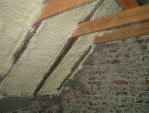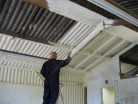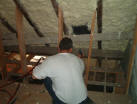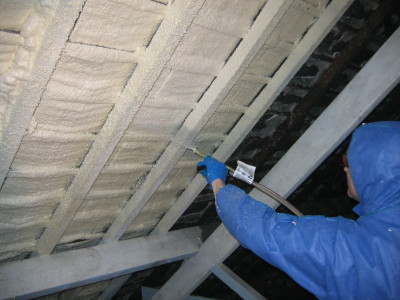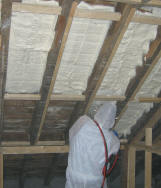Loft, Roof and Wall Spray InsulationHeat loss from a house or building occurs in almost every directions. The picture below shows the typical heat losses from a house through the various parts. Loft insulation & cavity wall insulation are simple and efficient ways to prevent heat loss through a roofs and walls. Energy savings could amount to as much as 40% depending on the type of insulation and the thickness. 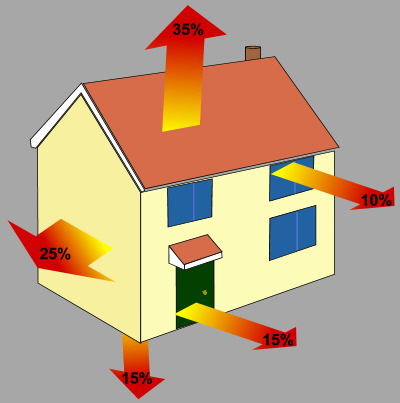 Insulation in loft spaces either at ceiling level or at rafter level will greatly improve the level of comfort in a house and significantly reduce heating costs. Where the insulation is installed between the rafters, this can create a living space in the loft or a "room in a roof" 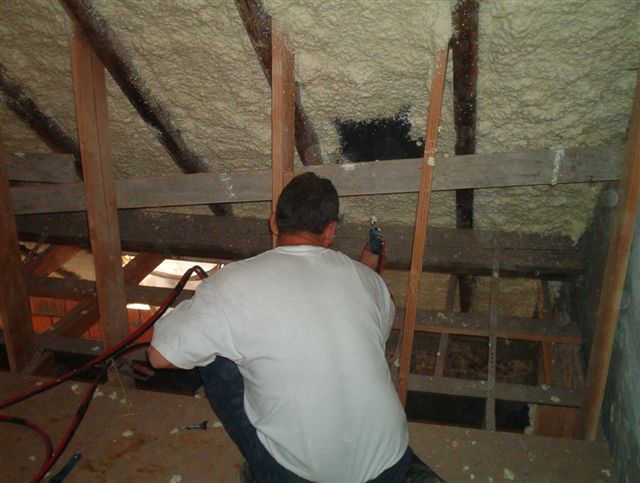 Loft Insulation BasicsWe all know that heat rises and thus tends to accumulate in the upper floors or lofts. Ordinary plaster board ceilings are poor insulators, and heat is lost through the ceiling and roof.
The formation of condensation on internal surfaces in cool weather is a very good indication of just how much heat is being lost through a lack of adequate insulation. What makes a good insulator? In simple terms, the insulating ability of a product is dependant on two main factors; the thickness of the insulation, and it's inherent ability to insulate (k-value). Generally, the thicker the insulation the better and the lower the k-value the better. These 2 factors are more often comdined and referred to as the U-value. The lower the U-value, the better the insulation. The UK building regulations have undergone several revisions over the past few years, with a particular focus on reducing the U-values in buildings through better insulation. For a guide to the current requirements of the UK building regulations, please follow this link to our building regulations guide Insulation MaterialsMany insulation materials are available - these range from materials like rock wool to expanded foams like polystyrene and polyurethane foam. Rock wool is a ceramic fibre, which is woven into a thick mat. It is available in rolls for insulating horizontal ceilings and batts & boards, for insulating walls and pitched roofs. It's main disadvantage is that it needs to be very thick to insulate adequately (often up to 12 inches thick to prevent condensation). It also has to be "fixed" in place and does not respond well to moisture (from roof leaks). Polystyrene and polyurethane foams are amongst the best insulation materials known to man. They insulate so well that they can be relatively thin. Polystyrene and other board insulation is time consuming to install as it must also be cut and fixed into place. Spray applied polyurethane can be sprayed into place, which greatly simplifies and speeds up the installation. Spray foam therefore offers significant benefits over other forms of insulation. Firstly it can be applied quickly whereas sheet foam has to be accurately cut and fitted. Other important advantages of spray applied foam include: Sprayed foam adheres well to under-felt and even roof tiles, which will stabilise the roof structure and prevent tile slippage. Spray foam has a closed cell structure which make it impervious to moisture, thus, the foam has excellent damp-proofing qualities as it seals the roof from the inside. Spray insulation can easily be applied as a DIY project, therefore cutting the cost of hiring expensive specialist contractors. The foam is simply sprayed onto the underside of the roof tiles, under-felt or roof sheeting. For any further advice, please contact us and we will be happy to give you any advice you might need. For a detailed information on insulation costs, visit our insulation cost comparison page Tile Stabilisation with Spray FoamSpray foam insulation is ideal for roofs suffering from nail fatigue and tile slippage. "Nail fatigue" is the corrosion of the nails, which hold slates in place. Over time these nails corrode and the result is that there is nothing to hold the tile in place. Spray foam is widely used to stabilise tiles and slates in a cost effective manner and thus avoid a costly re-roofing. The foam is sprayed onto the underside of the tiles and battens where it bonds strongly, creating a water-proof and very stable structure, that will prevent the ingress of wind driven rain and snow. 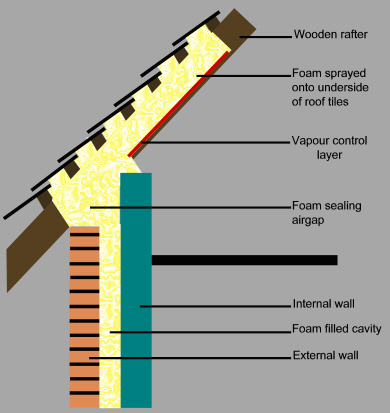 Loft conversions and new buildsSpray foam insulation can be applied between the roof rafters to insulate the roof in newly converted lofts, or to insulate roofs in new builds. A 50mm air gap does not need to be left between the insulation and the tiles. 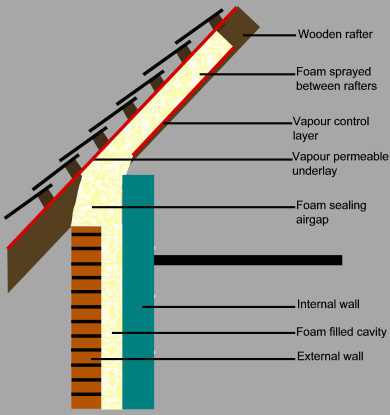 Wall InsulationThe concept of spray insulation extends to insulating conventional brick walls, and can be applied to internal surfaces (which can then be rendered with plaster or faced with plasterboard). This makes sprayed insulation ideal for insulating cellars and basements. The advantages are: fast, efficient application of insulation; good sound deadening properties & excellent damp proofing properties 
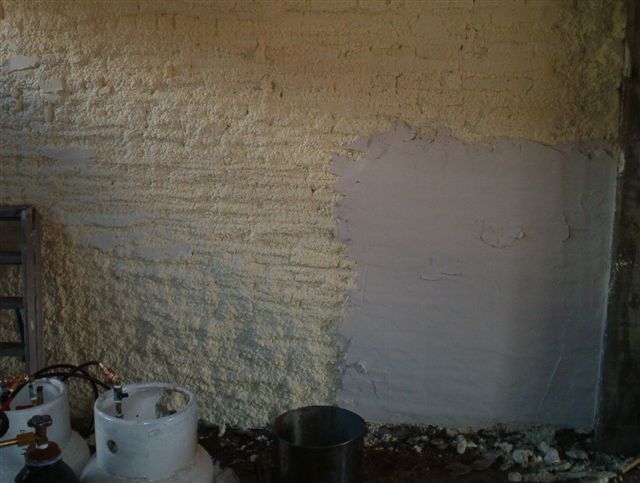
Barn InsulationTo find out more about insulating barn conversions with spray foam insulation, please click on the Barn Insulation button in the left column, or follow this link to Barn Insulation How easy is DIY Spray Insulation?Spray applied foam insulation is made simple with Handi Foam DIY spray foam kits. Follow the links on the left at the top of the page to visit our product & prices page and to find out more information about the foam kits. Why pay more than you have to when you can do it yourself? |
|

